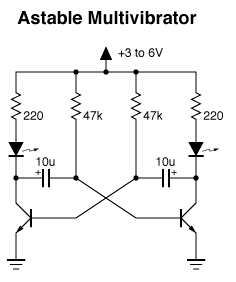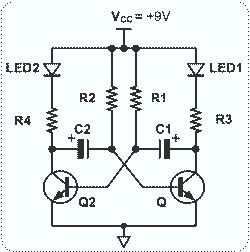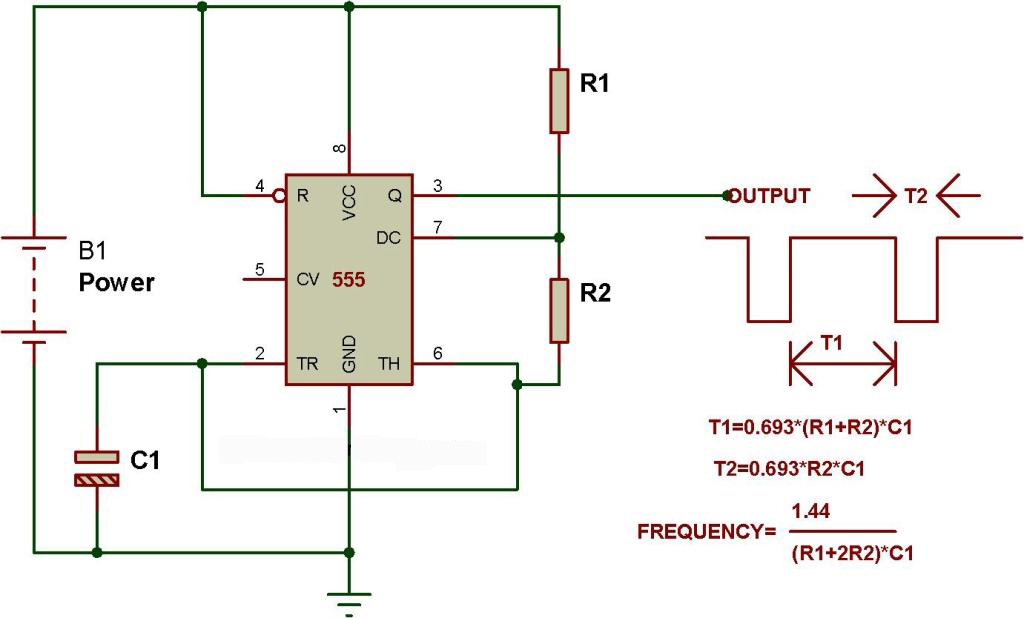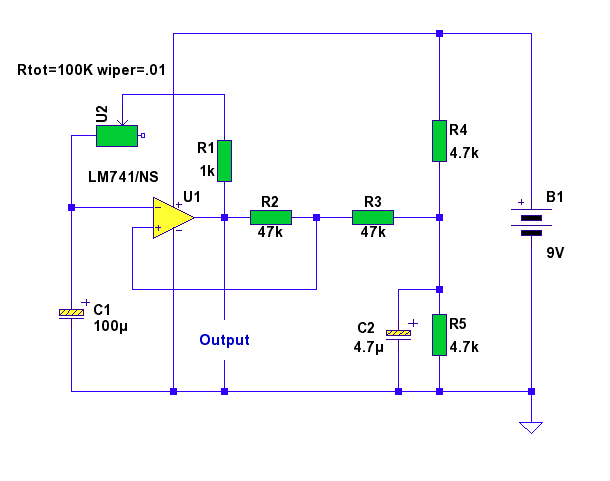
astable multivibrator

Two 47k ohm resistors, with alternative values ranging from 22k to 100k ohm, can be used. The value of these resistors affects the timing of the blinking; larger values result in slower blinking.
In a typical electronic circuit designed for blinking an LED or similar output device, the timing characteristics are often governed by resistor-capacitor (RC) timing circuits. In this scenario, the use of two 47k ohm resistors allows for adjustments in the timing of the blinking effect. The resistance values can be varied from 22k ohm to 100k ohm, providing flexibility in the circuit's response time.
When the resistance increases, the time constant of the circuit also increases, which leads to a longer delay between each blink of the LED. This is due to the relationship defined by the RC time constant formula, τ = R × C, where τ is the time constant, R is the resistance, and C is the capacitance. In this case, the choice of capacitors in conjunction with the resistors will determine the overall blinking frequency.
For instance, if a capacitor of 10µF is used in conjunction with the two 47k ohm resistors, the time constant can be calculated as follows:
τ = 47,000 ohms × 10 × 10^-6 farads = 0.47 seconds.
This indicates that the LED would take approximately 0.47 seconds to charge and discharge, resulting in a blinking interval that can be perceived by the human eye. By substituting the resistors with higher values, such as 100k ohm, the time constant will increase, leading to slower blinking rates. Conversely, using lower resistance values will yield a faster blinking rate.
In summary, the selection of resistor values in this circuit plays a crucial role in determining the timing of the blinking output, allowing for customization based on desired visual effects or functional requirements.* 2 x 47k ohm resisters anything from 22k to 100k ohm should work. Value of these changes the timing of blinking (larger the value, slower the blinking). 🔗 External reference
In a typical electronic circuit designed for blinking an LED or similar output device, the timing characteristics are often governed by resistor-capacitor (RC) timing circuits. In this scenario, the use of two 47k ohm resistors allows for adjustments in the timing of the blinking effect. The resistance values can be varied from 22k ohm to 100k ohm, providing flexibility in the circuit's response time.
When the resistance increases, the time constant of the circuit also increases, which leads to a longer delay between each blink of the LED. This is due to the relationship defined by the RC time constant formula, τ = R × C, where τ is the time constant, R is the resistance, and C is the capacitance. In this case, the choice of capacitors in conjunction with the resistors will determine the overall blinking frequency.
For instance, if a capacitor of 10µF is used in conjunction with the two 47k ohm resistors, the time constant can be calculated as follows:
τ = 47,000 ohms × 10 × 10^-6 farads = 0.47 seconds.
This indicates that the LED would take approximately 0.47 seconds to charge and discharge, resulting in a blinking interval that can be perceived by the human eye. By substituting the resistors with higher values, such as 100k ohm, the time constant will increase, leading to slower blinking rates. Conversely, using lower resistance values will yield a faster blinking rate.
In summary, the selection of resistor values in this circuit plays a crucial role in determining the timing of the blinking output, allowing for customization based on desired visual effects or functional requirements.* 2 x 47k ohm resisters anything from 22k to 100k ohm should work. Value of these changes the timing of blinking (larger the value, slower the blinking). 🔗 External reference





